Cheap Mirais with $15,000 worth of free fuel looks like a good deal before you consider these risks.
Certified Pre-Owned Toyota Mirais priced at around $10,000 with 40,000 miles on the odometer are currently hitting the used car market. With a free fuel card that’s supposed to last three years, and nothing coming out of the tailpipe but water, you think you’ll drive it till your fuel card runs out, you’ll have few problems since it’s sort of an electric vehicle, and, you’re doing the environment a favor. Not really.
Here is a list of mistakes and misconceptions you need to know before pulling the trigger on a CPO Mirai.
Your Mirai experience is largely shaped by what H2 station you live nearby and how reliable it is.
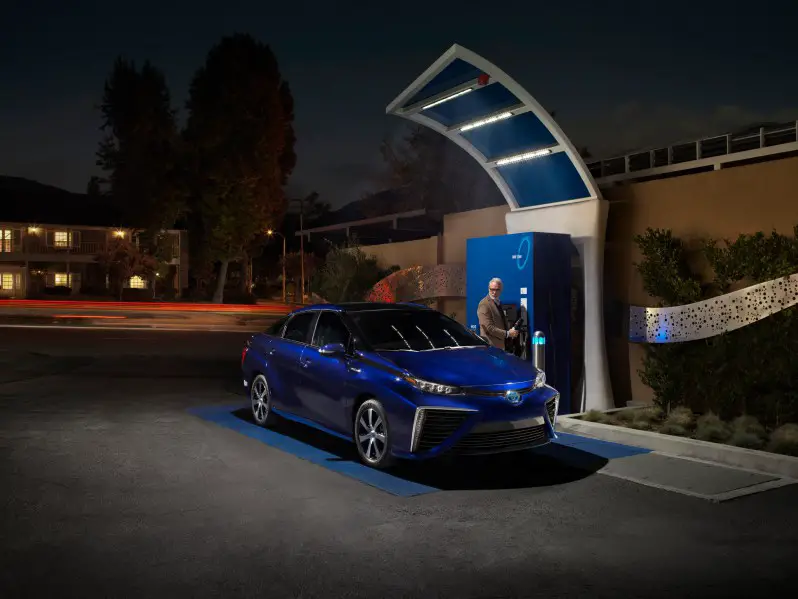
Today, there are only 45 Hydrogen Refueling stations open in California concentrated in Northern and Southern California. A quick look on H2-CA.com reveals only 3/4s of those stations are actually up and running, and this is par for the course for the entire H2 infrastructure. Unlike gas stations, hydrogen re-filling stations are several times more complicated to run and are notoriously unreliable.
Also, whereas regular gas station tanks with their 12,000 gallon on-site storage tanks can fill up around 750 vehicles before the fuel truck comes in, Hydrogen stations typically only hold around 200 kilograms of H2. Since most H2 cars hold around 5 kg, only 40-50 Fuel Cell Vehicles can be filled before you have to wait for a delivery.
In a perfect H2 infrastructure with everything running 100 percent, they schedule deliveries taking account traffic but, if one station goes down, fuel cell vehicles will re-reroute to the nearest open station, overloading that station’s capacity.
If you plan to commute with your Mirai, it would behoove you to monitor the station near where you live, see how often it runs dry, and its overall reliability during a normal commute week span.
You won’t get 312 miles of range
While the EPA Estimated range is 312 miles, that was on an EPA test cycle held at an ideal 70 degrees with full tanks. Toyota states, Actual mileage will vary.” According to several Mirai owners on the Facebook Mirai’s owner’s page, they typically see 240-260 miles of range in mixed city and freeway driving. If you drive conservatively on a cool day, you might crack 290 and above.
Considering a KG of hydrogen costs around $16.50 and you’ll come in near empty, expect to drain about $75 from your card every fill up. Some back of the napkin math reveals, if you want to use your card to its full $15,000 potential, you can buy about 909 KGs of H2 total or about 303 KGs a year.
If 250 miles of range for five kilograms means 50miles/kg, expect to budget about 15,150 miles a year. If you drive more than that, in less than three years you’ll be forced to buy your own H2 fill-ups.
There’s a mandatory Ion Exchange Element and Fuel Cell Cooling System fluid top off every 30,000 miles that costs upwards of $1,000.
Since this is a niche vehicle, one of the largest mandatory maintenance items is the Ion Exchange Element replacement. The IEE is literally one of the most important parts of the fuel cell, responsible for facilitating the delicate chemical reaction between protons (H+) from the hydrogen electrode to the oxygen electrode that ultimately makes electricity. The IEE is sort of like the cylinders in your car, containing and directing combustion for mechanical power.
Although the IEE is only a $220 part, since only certified Toyota Mirai techs can work on your Mirai, you’ll pay for the leadership labor. If you go for Toyota’s 30,000 mile service with everything you’re supposed to do, it’ll cost you upwards of $1,000. Do just the IEE with labor and you’re looking at around $600.
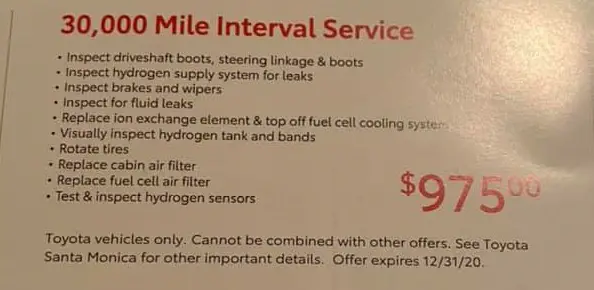
If your used Mirai is just under 30,000 miles or close to multiples of 30,000 miles (60,90,120 etc.) you have an expensive maintenance service in your future.
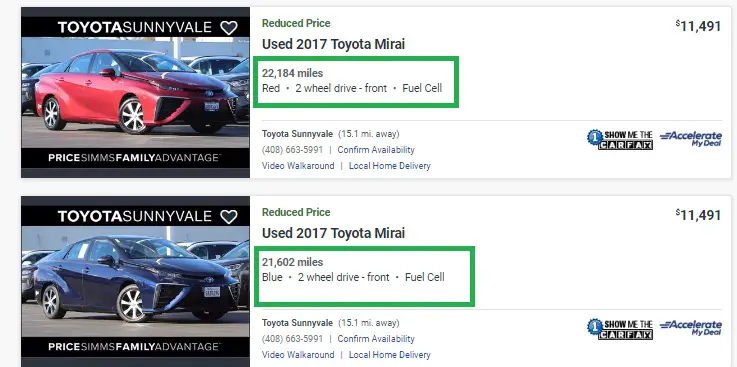
Sorry, you’re still using non-renewable hydro carbon gas.
If you’re think you’re saving the environment, at this point in time, you’re not.
According to the California Fuel Cell Partnership,
Most hydrogen is made by steam reforming natural gas. It’s an efficient and cost-effective process process where CH4 reacts with high-temperature steam (H2O) in the presence of a catalyst to separate the hydrogen from other molecules.
CH4 is the chemical formula for methane A.K.A. a natural gas. Hydrogen gas supplied to H2 stations in California is mostly made by Air Products. AP uses steam reformation.
Just like EVs, your “tailpipe” is at the steam reformation factory.
Potential maintenance horror nightmares
While the Mirai ownership experience should be relatively worry-free, refueling aside, know that you are dealing with a fuel cell vehicle here. This is uncharted used-car territory.
Electrolyzation, the process in which Toyota’s Fuel Cell gets current from hydrogen, is a violent (at the molecular level) and delicate process.
If you don’t know how FCVs work, it would behoove you to watch Toyota’s video below.
The Mirai uses bespoke parts not shared with other Toyotas and maintenance can potentially get expensive, fast.
There’s a horror story on KBB.com where a Mirai owner bought a cheap Mirai, no warranty (not a CPO) and damaged the three-tank system. With each tank at $7,000, she could not afford the repairs and presumably sold her Mirai at a loss.
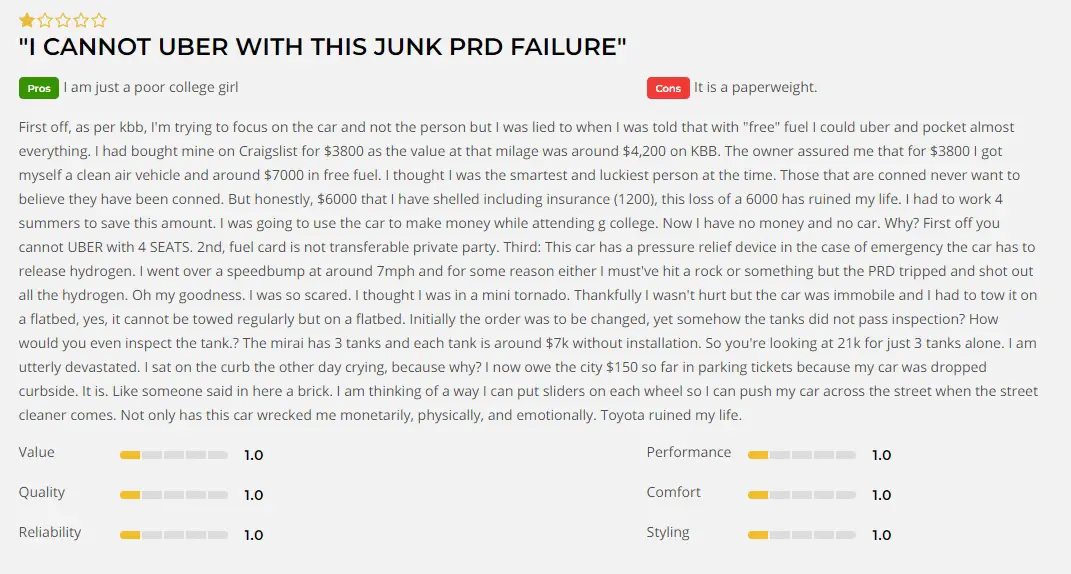
Most Mirai owners report an OK Fuel Cell Vehicle experience. If you live near a reliable station, have a back-up car, and don’t mind rolling the dice on an experimental vehicle, a CPO Toyota Mirai might be for you.
If you need reliable transportation with a robust refueling infrastructure, just buy a gas Corolla or equivalent.


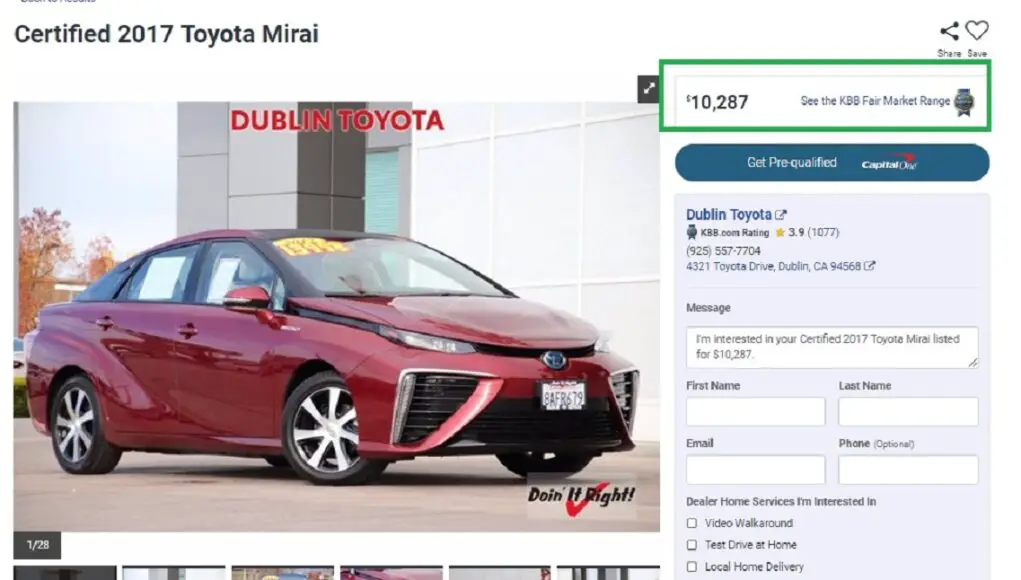

Five years with my Mirai, never stranded, and I needed to go to a secondary refueling station *once*. If with steam reformation of methane, my green house gas emissions are much lower than a gasoline fueled car, so *yes* I am helping the environment. It’s not for everyone. Five years and no regrets.
What is price for New fuel cell stack?
According to one Mirai lessee who had to have their FC stack replaced, “Replacing the fuel cell stack costs over $50,000 on the Gen 1 Mirai. I was told it would cost about the same to replace the Gen 2 Mirai fuel cell stack if it’s out of warranty… To remove and reinstall the fuel cell will require 24 hours of shop labor at $155/hr at Longo, California Toyota.”